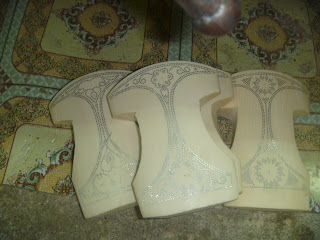Ever since I posted the "guns are fun" post I've been thinking a lot about what I saw on my trips to the Middle East. Before firearms made it into the hands of the people Middle East the main weapons were the traditional swords, daggers, and knives. Although dated, the culture of the Gulf still retains the carrying of the traditional knives for symbolic purposes. It is particularly strong in the UAE, Oman, Yemen, and southern Saudi Arabia. The Khanjar (dagger in Arabic) or Jambiya (Yemeni colloquial for their style of dagger) are still hand made and worn by men. This tradition has been challenged by globalization but still retains a distinct identity marker for special occasions like weddings, eid's, national holidays, ect.
Every dagger is different and their design can give away what region they were from/who would have worn it. The daggers reflect the lifestyle of the wearer in some cases. I am also doing a translation piece for my Arabic class on ship building and turns out that their are special types of daggers used by sailors and fishermen.
The following pictures are all off the internet but I will describe their significance.
http://www.posterlounge.co.uk/traditional-khanjar-dagger-strapped-to-waist-of-omani-man-pr76327.html
This is the typical contemporary use of the traditional daggers in the Arabian Peninsula. Above is an Omani man dressed up for a celebration. Notice he has three weapons, his dagger (khanjar in Arabic), sword, and pistol. In his other hand he should be carrying the rawhide shield. Celebrations and dances called Aazis incorporate all these items.
Below is a group of Yemeni men wearing their daggers, locally called the jambiya. Notice the plain design and the shape of the belt and scabbard.
http://www.google.com/imgres?hl=en&safe=off&sa=X&tbo=d&biw=1366&bih=600&tbm=isch&tbnid=vC6MtFSC5F6BRM:&imgrefurl=http://pictures.traveladventures.org/images/yemenipeople02&docid=6hqB32fMPnEzeM&imgurl=http://www.traveladventures.org/continents/asia/images/yemenipeople02.jpg&w=500&h=375&ei=A8OyUKacDc6_0QHe24GgCg&zoom=1&iact=rc&dur=328&sig=114300205124519470858&page=1&tbnh=130&tbnw=163&start=0&ndsp=21&ved=1t:429,r:7,s:0,i:123&tx=36&ty=81
Here you can see the daggers being worn in the late 1940's by British Explorer Wilfred Thesiger and his bedouin accomplices. Up until the modernization of the Gulf in the 1970's the daggers still played an essential part of daily life being used as a tool. Wilfred Thesiger wrote specifically about the usage of the daggers he and his friends wore in his book "Crossing the Sands".
Types of daggers:
This is a typical example of the dagger made and carried in Oman and the UAE. I've also seen members of the royal families in Jordan, Bahrain, Saudi Arabia carry them for ceremonial purposes.
This picture shows how the daggers are designed for specific purposes. According to an online Omani source the smaller dagger (top) would be used by fisherman because they are easier to wear and work while on a ship. The larger dagger (bottom) is the regular size that would be used by people inland.
Oman is unique because it has an official style of dagger known as the Saidi style. According to what I have been told by Omani's and what I have read this design was created by the wife of the Omani Sultan in the mid 19th century using Indian designs for the handle. The one I have pictured here has the Saidi style handle with a ton of silver filigree over the rhino horn handle. Oman and Yemen are also interesting because tribes have distinct dagger styles. The Saidi tribe is the Sultans tribe and would have daggers like the one above while other tribes will have more rings added to the scabbard.
Outside of Oman the size, shape, and design of the daggers change. These two daggers show features that give away their origin. These daggers are from the Asir region of southern Saudi Arabia that borders Yemen. The upward point of the scabbard, belt design, and the cast silver parts are the key differences.
Here is a typical Yemeni Jambiya. Notice the belt, the design of the scabbard, and the wide blade. Yemeni knives can be huge and although they aren't decorated with silver like other types of daggers the handle is the most important part. A true Yemeni jambiya worn by a person of importance would have a rhino horn or other rare horn handle.
This style of dagger is from the southern region of Oman along the Yemeni border. Notice how silver is used and the size of the blade.
Like the previous dagger this is a typical design found in the southern region of Yemen and into southern Oman. There is more silver work than the other Yemeni jambiyas and the scabbard doesnt point up but the belt is the same wide style and the handle is the same.
I find all this interesting because the daggers tell much more than one realizes. There isn't a lot of research on traditional daggers but from talking to my friends and searching around on google I have learn to tell where people are from/what they do from the blades they carry.
Of course each dagger is handmade and one of a kind.
http://www.vikingsword.com/vb/showthread.php?t=14878&highlight=omani+scabbard
http://www.oriental-arms.co.il/


















